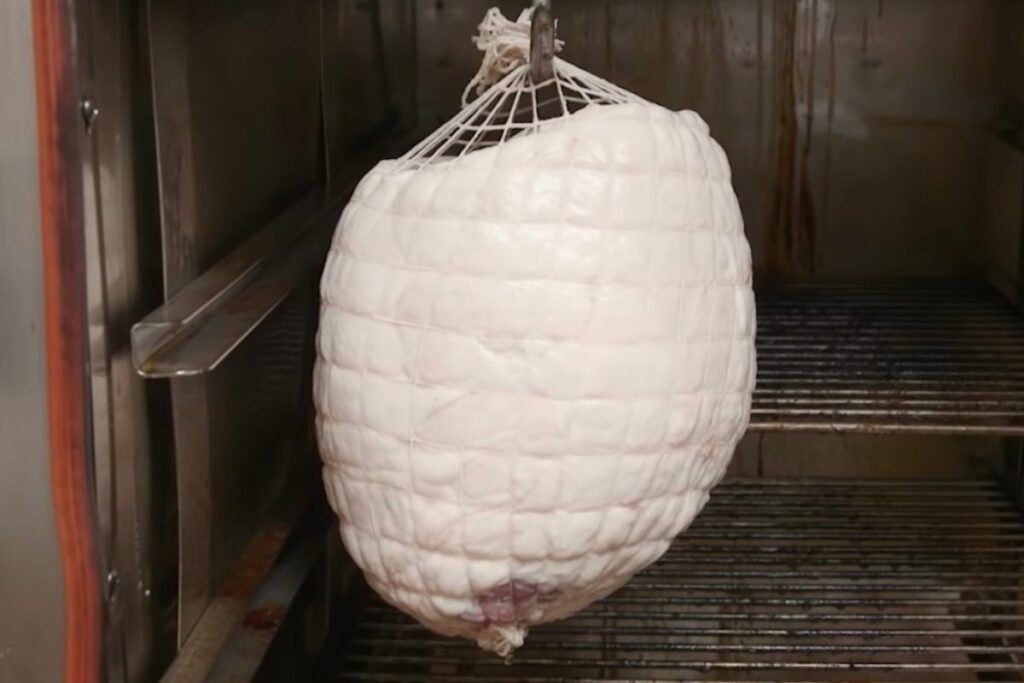While ham and pork both come from pig, the two exhibit a number of different characteristics.
Mainly the fact that ham is technically a cut of pork, while pork is a term used to refer to all of the various cuts of meat that come from domesticated pigs.
With this in mind, it’s important to understand that the two terms “ham” and “pork” shouldn’t be used interchangeably.

In this guide we’ll take a look at some of the main differences between ham and pork, and explain why differentiating between the two is so important when it comes to storing, preparing, and consuming both ham and pork.
Furthermore, we’ll also look to answer a number of the frequently asked questions related to the two popular cuts of meat.
A Closer Look At Pork
The term “pork” is given to all meat that comes from domesticated pigs. Pork is most commonly sold raw, so it needs to be cooked before it’s eaten.
Pork can also be cured, which means the meat is preserved to be safely eaten in that condition. Ham is one of the most prominent examples of cured meat, but there are numerous others.
Interestingly, pork accounts for around 40% of the world’s meat production.
What’s more, although some religions are strongly against the consumption of pork and other pork-related products, it still remains by far one of the most popular sources of protein around the world.
A Closer Look At Ham
The term “ham”, on the other hand, refers to meat that’s made from a very specific part of the pig – its hind leg. Ham is also cured, meaning that the flesh of the meat is preserved through smoking, dry-brining, or wet-curing.
In other words, this essentially means that ham doesn’t need to be cooked in order to be safely consumed, although many people believe that the meat tastes better when it’s heated through a little bit.
The Differences
Now that we’ve provided a brief explanation of the two, it’s time to take a look at some of the main points of difference between pork and ham. Listed below are four of the most important to keep in mind.
Flavor
Pork provides a mild flavor, especially in its original state. This makes it a great base for various marinades, sauces, and rubs.
The leaner the cut of pork (such as pork tenderloin), the milder the flavor, whereas the fattier cuts offer a much richer flavor.
On the other hand, ham provides a smoky and salty taste. So, while it may be possible to replicate the stronger flavors of ham with the right combination of seasonings, the meat is considerably more flavorful than regular pork.
Color
In terms of color, pork typically exhibits a pale pink color when sold raw. This can sometimes be a little darker depending on the type of cut.
For example, the leaner cuts like chops and tenderloin are lighter in color, while fatty cuts such as belly and butt tend to be notably darker.
By contrast, ham has a distinctive deep pink due to the curing process. What’s more, the exterior of the meat often exhibits a glazed appearance, with slight hints of red and orange.
Preparation And Cooking
When buying raw pork, it’s essential that you cook it off before any kind of consumption. This provides you with a fair amount of flexibility when it comes to preparation.
Pork can be cooked in a number of different ways, whether that’s roasted, grilled, pan-seared, baked, or braised. You also have complete control over the seasonings you can use with the meat.
Furthermore, pork is free from food additives. So if you’re someone who worries about dietary and health factors like sodium content, pork is the better choice over ham.
Cured ham, on the other hand, is sold ready to eat, with the meat often sliced and readily prepared as a sandwich filling.
While cold ham is perfectly fine to consume, heating the meat brings out a lot more flavor and gives the flesh a more appealing and softer texture.
Just keep in mind that ham also contains sodium nitrate as a preservative. In fact, it’s this additive that contributes to the meat’s dark pink color.
Longevity
It’ll probably come as no surprise to learn that preserved meats like ham have a considerably longer shelf life than raw products.
For example, a country ham can be kept for as long as a week when refrigerated, while dry-cured meats like prosciutto can be left at room temperature for up to three months.

When buying raw pork, it’s best if you try to cook it the same day.
If not, you can keep it in the fridge for between three to five days, and if you suspect that you won’t have the chance to cook the pork within this time, you should store it in the freezer.
While ham can also be stored in the freezer, it doesn’t keep quite as well. Ham that’s frozen should ideally be thawed and consumed within a month, whereas raw pork can be kept in the freezer for up to 12 months without suffering any adverse effects.
Pork Recipe Ideas
When it comes to using fresh pork, the options are pretty much endless. However, if you’re not sure where to start with the popular meat, listed below are three of the most common recipe ideas.
Saute thin strips of pork tenderloin in a ginger-soy sauce combination to make a delicious stir fry. You can also add onion, broccoli, carrot, hot red pepper flakes, and then serve over either rice or noodles.
Use a blend of Dijon mustard, cayenne pepper, and maple syrup to brush some pork chops, before cooking over a medium-high heat.
Use your favorite BBQ spice rub to smother a ten-pound pork butt and cook it around 225℉ for just under 20 hours. The meat will fall apart when you cut into it, providing the ideal base for pulled pork sandwiches.
Ham Recipe Ideas
While ham provides a very distinctive flavor profile, this doesn’t mean that it lacks versatility and is difficult to use in various dishes. Listed below are three of the most common recipe ideas for using ham.
Scramble some eggs together with diced ham, green pepper, minced onion, and cheese to make a drool-inducing Western omelet.
Saute diced ham with shallots and toasted walnuts, before tossing the mixture with freshly cooked spaghetti and topping with parmesan cheese and minced parsley.
Mix some diced ham with Dijon mustard and mayonnaise to form a basic but delicious ham salad. This can be served in brioche buns or hot dog rolls.
Frequently Asked Questions
What’s The Difference Between Ham And Prosciutto?
Similar to ham, prosciutto is another cured pork product. However, while it’s sometimes referred to as “prosciutto ham”, it’s important to keep in mind that prosciutto isn’t the same as regular ham.
Prosciutto di Parma must come from a specific region. In other words, the pigs have to be born and raised in Italy.
What’s more, the diet of the piglet must also consist of the whey from Parmigiano-Reggiano, which is the hard, salty cheese that the region is famous for.
There are several other appellations for prosciutto, including the well-known prosciutto di San Danielle. This form of prosciutto is softer, darker, and provides a sweeter flavor than prosciutto di Parma.
Can You Substitute Prosciutto For Regular Ham?
You can, but only in very rare cases. For example, if you’re only using very small amounts of ham as part of a salad topping or soup ingredient, then prosciutto can be a suitable replacement.
However, if you’re making a ham sandwich, prosciutto is considerably saltier than regular country ham. Moreover, it also has a stringy texture that can prove difficult to eat unless you crisp it beforehand.
What’s The Difference Between Ham And Bacon?
Unlike ham which is cut from the hind leg of a pig, bacon is pork meat that’s cut from other parts of the animal, including the loin, collar, back, or belly.
Is Pork Good For You?
Yes, pork is an excellent addition to any diet as it’s a rich source of essential vitamins and minerals like iron and zinc that your body needs to function.
What’s more, it’s also a great source of high quality protein, which can provide you with several other important health benefits.
The Bottom Line
As this guide has shown, both pork and ham have their advantages, so if you were looking for a clear winner we’re sorry to disappoint.
Picking the better option is mainly dependent on the dish you’re planning to cook and how much time you have to prepare it.
While pork is certainly the best choice for healthier and more diverse dishes, the distinctive flavor and texture of cured ham is difficult to beat.
Needless to say, you shouldn’t have any significant issues with either, so best of luck!
- Is Blue Steak Safe To Eat? - May 7, 2022
- How To Tell If Your Bratwurst Sausage Is Cooked - May 7, 2022
- The Internal Temperature For Tri Tip When Done - May 7, 2022








